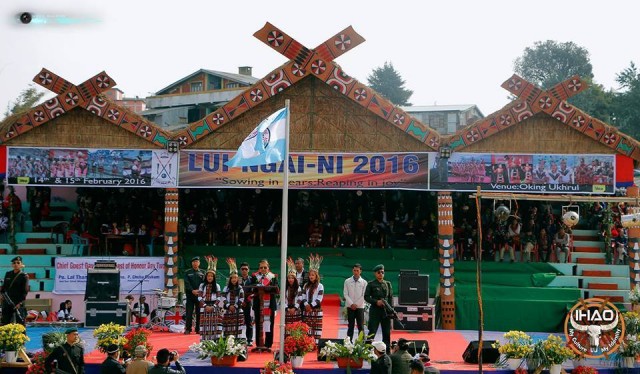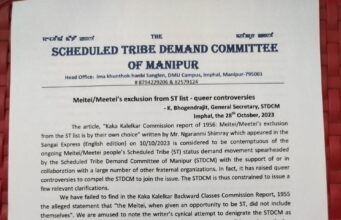By Aheibam Koireng Singh
There is confusion as to the actual number of Naga Tribes. Lt. Gen. (Retd) Sushil K Pillai, former IG of the Assam Rifles, proposes a working figure of 35 Naga tribes. Prakash Singh, former DGP in Assam, refers to 14 major Naga tribes. The memorandum submitted to the Simon commission in 1929, by the Naga Club, mentions eight tribes within the administered area. Murkot Ramunny, an Indian Frontier Administrative Service officer who retired as Adviser to the Governor of Nagaland, says there are about twelve major tribes.”
The view of the Naga insurgent outfits is also important as their actions have the capacity to influence macro-level phenomena and continue to determine certain collective praxis. V. Sumi and K. Timothy’s compilation Cry for Justice, published and brought out by GPRN, NSCN (IM) in the later part of 1990s mentioned 38 tribes living in Assam, Arunachal Pradesh, Nagaland, Manipur and Eastern Myanmar as belonging to the Naga. Out of that, 18 of them belonged to Manipur, namely, Aimol, Anal, Chiru, Chothe, Kharam, Koireng, Kom, Maring, Mayon, Monshang, Lamkang, Mao and Maram, Thangal, Poumai, Tangkhul, Tarao, and Zeliangrong.
According to Prof. Gangmumei Kamei, identification with the Nagas has been a process of pan-Naga identity. The term ‘Any Kuki Tribe’ was deleted from the list of Scheduled Tribes of Manipur in 1956.In the years that followed, there was a deep internal crisis of identity amongst the Kuki-Chin speaking tribal population. A number of the bridge-buffer communities that were oscillating between the Naga and the Kuki-Chin constellations were converted into the Naga fold by the Nagaisation process and they joined the Naga movement. The Nagaisation process was also greatly strengthened by the Naga insurgency. Marings have come to identify themselves as Naga at the instance of Church leaders and the Naga hostiles.
In the early part of 2002, the NSCN-IM suggests a number of tribes in the Naga fold as 43. Instances of tribes being encompassed within the Naga fold is still an ongoing process. The simple example of it is the Peace Process Annual Calendar, 2008, MIP, Government of the Peoples Republic of Nagalim, in which the number was expanded to 68.
Among those tribes from Manipur are: 1.Anal; 2. Angami; 3. Ao; 4. Aimol; 5. Chiru; 6. Chothe; 7. Inpui; 8. Kharam; 9. Kom; 10. Lamkang; 11. Liangmai;12. Maram; 13. Mao; 14. Maring; 15. Mayon; 16. Monsang; 17. Poumai; 18. Rongmei; 19. Tarao; 20. Wung Tangkhul; 21. Thangal; 22. Zeme.
Sajal Nag (Naga Identity: Formation, Constructing Expansionism, eds., Thomas, C.J., Dimension of Development in Nagaland, Delhi, 2002) stated that the Naga identity in the 1940s included the Karbis and Nepalis but excluded all the sub-tribes of Manipur. The present Naga tribes of Manipur did not know the term Naga as late as 1940s, Shimray stated. He recorded his boyhood experience when he and his father were called Naga by a retreating Japanese troop during World War II.
He and his father told the Japanese troop that they were Tangkhuls and not Naga. The Nagas in Manipur did not take part in the 1951plebiscite, which was considered as the bedrock of the Naga independence movement. In 25 January1952, the Nagas in Nagaland under the banner of Naga National council (NNC) launched civil disobedience movement. As a part of it, the first Indian elections of 1952 were successfully boycotted.
On the other hand, in Manipur all the ethnic groups took active part in the said elections and a Tangkhul was elected from the Outer Parliamentary Constituency. Later, the GoI made an agreement with the NPC in 1960 and subsequently formed Nagaland as the sixteenth state of the India in 1963. It is noteworthy that many of the prominent leaders of the tribes who were later to be identified as Nagas stuck to the stand of remaining with Manipur instead of acceding to Nagaland. The All Tribal Delegation went to Delhi in May 1970 for demanding statehood of Manipur.
The members of the said delegation include:
1). Daiho, Ex-Finance Minister, Manipur Assembly, 1948
2). Stephen Angkang, Ex-President, Tangkhul Long
3). K. Kalanlung, President, Zeliangrong Regional Council
4). Shoukhothang Ashon, Ex-MLA.
Nagaisation process, according to Gangmumei Kamei is still ongoing. Considering the diversity in the emergent Naga Nationhood, there has been remark that Naga Nationhood is more like a marriage of convenience rather than socio-historical process. Divorce can follow any time. Zeilangrong is a nomenclature of the three sub-tribes, Zemei, Liangmei and Rongmei. This nomenclature is formed by the initials of the three sub-tribes, Ze for Zeme, Liang for Liangmei, and Rong represent Rongmei.
But Puimei who were included as the sub tribe of Kabui in the scheduled tribes list of Manipur asserted that they cannot be identified as ‘Zeilangrong’ as Puimei had not been represented in the nomenclature. Zeliangrong has aspiration for exclusive ethnic homeland of its own. But the Puimeis who together with the Rongmeis formed main groups within the Kabui did not take part in it. They now prefer the ethnonyme, “Inpui” instead of Zeliangrong. Among the constituent Naga tribes, the Naga identity has shown fragmentation at the intra-tribal level. It is evident when the Puimeis wanted to break away from Zeliangrong and the Khoibus from Marings.
Lui-Ngai-Ni represents only the three biggest communities in the present Naga fold, that also in head-middle-tail order corresponding to their population size, the head represented by Tangkhul festival ‘Luira’. Lui-Ngai-Ni, in public notice, remains a political festival, observed only at the district headquarters where Naga Community based lobby groups used its festive ambience to further their political machinations like severing of ties with state government, separate administration, etc.
Social-gatherings, songs, colorful dances, glittering fashion shows and rejoicing continuingly passes on to be the highlight of the Lui-Ngai-Ni with this time also TR Zeliang and Lal Thahawla respectively the Chief Minister of Nagaland and Mizoram taking part in it which is to start with invocation in probably Tangkhul dialect by Tangkhul Headman of Ukhrul/Hunphun village. Even then, the festival in this present layout is no tribute to those who are now in heavenly abode or on their twilight years being in advancing old age, but in their prime time 30 years before or so, have contributed all what they have, their head, heart and hard labour in assembling Lui-Ngai-Ni so that the Manipur Nagas of the present generation joins the ‘comity of nations’ with a ‘common festival’ which will be the ‘national festival’.
Why because? It has not been filtered down to and no community at the present Naga fold observes it at the village level. The countdown of this festival begins from 1987 as this festival, though not with its present name, was first observed in the year 1987 in its proto format as ‘Naga Seed Sowing Day’.
The festival doesn’t in anyway help in concretizing the Naga identity which is still at the abstract level. With only three communities being represented in the etymology of Lui-Ngai-Ni, the issue of ‘exclusion’ and ‘inclusion’ is very much there. Correspondingly, it doesn’t seem to serve any purpose in boosting the morale and strengthening the bond of Naga solidarity.
Therefore, our fellow native brethren, the Manipur Nagas as people with unique history needs to review and scrutinize whether the present form of Lui-Ngai-Ni requires redefinition, reconfiguration or a reinvention of altogether new festival, with all the qualities of uniqueness so that all the tribes in the colorful Naga identity will not feel left out and collectively share and cherish an encompassing and inclusive feeling.
Concluded.
Lui Ngai Ni – Unique Festival For People With Unique History – Part I











God Loves Manipur…!!!
Nangi Yaifare do wahei khuding pandabadi kaibra, ebungo
Now is near for 3world war! Ha ha ha ha…………………. ——-!
Yaifare!
Think before 2015 what is there now what!
Yaifare!
He he he.pillai is south india person.he think nang+ga( necket person they living in jungal forest).he is guiding d fore.
Only a few are making all these troubles, it’s wrong to put the tribals in one bracket. We have a lot within our own meitei community also.
700 army where they go in around waiting for ther call in 1840 to 1850 Ad!
Meiteis were kick in their butts
He ha like!
I still believe all Kukl are not Barbarian
Hare Krishna!!
Krishna is not ur god.
My fathre n forefather mangang!
Is my got!
Yaifare!
God haige touni!
Ignorant, irresponsible writeup and comments
How about you Babu!
Yaifare!
Now especially meitei will take a chance to criticise our festival. Funny people.
Their uniquenss is only one
that is they dosn’t have any history.
Jealous?
Is it a festival or a protest?
Moigee waareesee mayaamna pngnei neinbseeda mkhoisee pngchao chaothokley mtam khra pothaba yaaroidra